Honor Award
The Flux City: Reframing Willet’s Point
Chuhan Zhang, Student ASLA, Graduate, Harvard Graduate School of Design
Faculty Advisor: David Mah
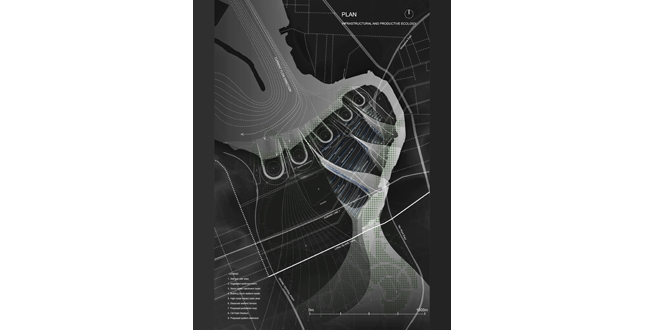
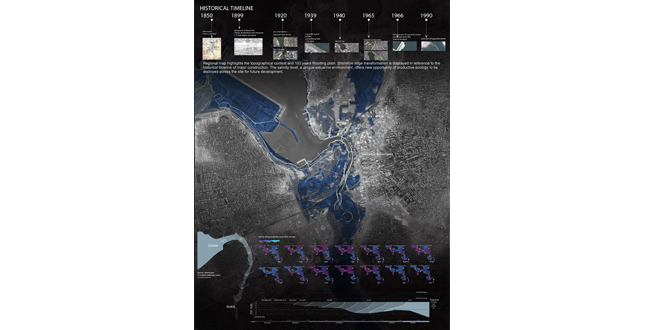
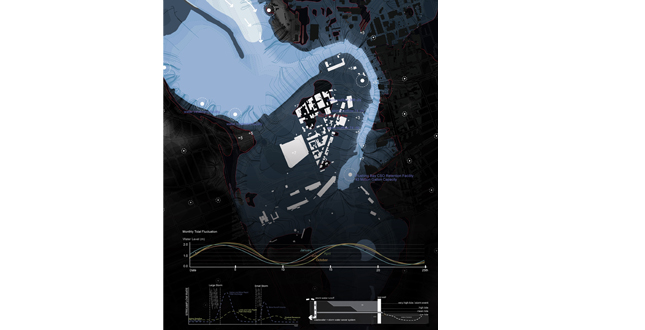 Close Me!
Close Me!The site map emphasizes on the hydrological context as well as the existing infrastructure including CSO outflow station. Identifying the surface runoff and watersheds, building footprint on Willet’s Point allows for keeping track of the contaminant flow.
Download Hi-Res ImageImage: Chuhan Zhang
Image 3 of 14
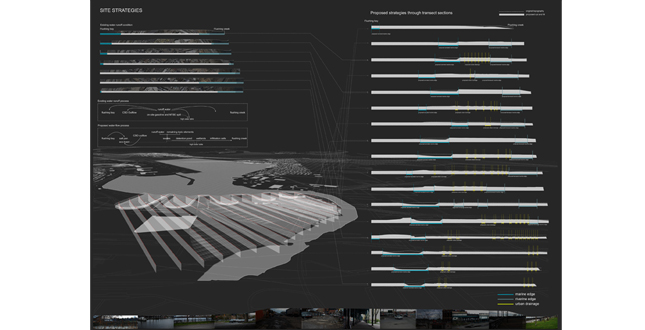 Close Me!
Close Me!Site Strategies. Systematic site strategies through sectional analysis embrace both the marine and riverine ecology Major site transformation is through reframing the edge, altering from hard, impenetrate edge to soft, dynamic and more productive edge allowing for a better solution of the Flux City, which the intake and outlet of water is better controlled and managed.
Download Hi-Res ImageImage: Chuhan Zhang
Image 4 of 14
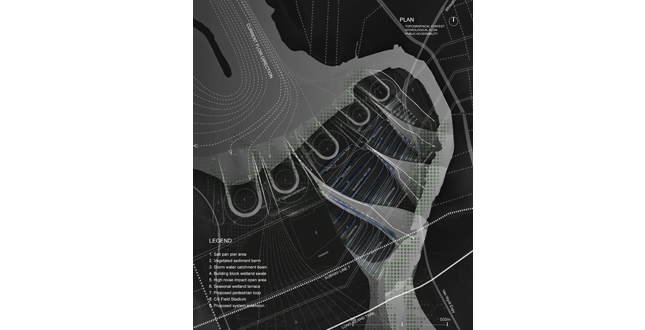 Close Me!
Close Me!Plan. Plan highlights the dynamic flux condition of the site proposal. Manipulated topographical condition, managed stormwater flow direction, sea water catchments basins and proposed circulation system provide great potential for healthier development of an urban estuary.
Download Hi-Res ImageImage: Chuhan Zhang
Image 5 of 14
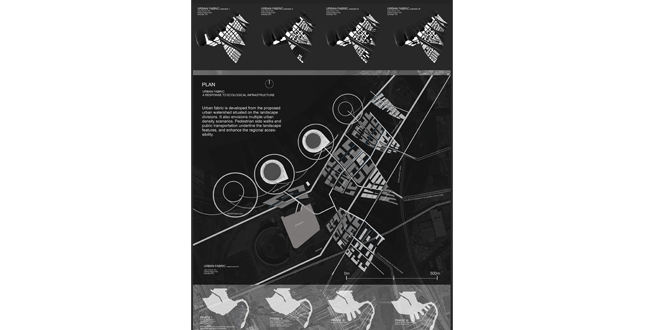 Close Me!
Close Me!Plan. Urban fabric is developed from the proposed urban watershed situated on the landscape divisions. It also envisions multiple urban density scenarios. Pedestrian side walks and public transportation underline the landscape features, and enhance the regional accessibility.
Download Hi-Res ImageImage: Chuhan Zhang
Image 6 of 14
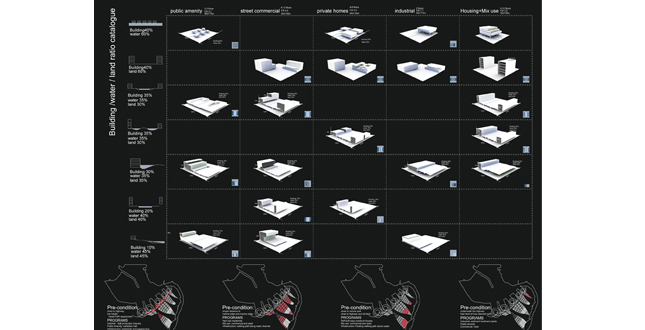
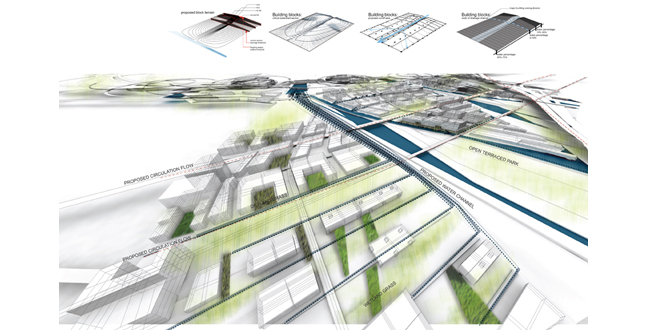 Close Me!
Close Me!Building Block Drainage Typologies. Block drainage system is deployed across the site from the typological studies. The manipulated flow pattern of building block decides the division line and water-land ratio. Perspective below shows building size and height controlled from drainage condition. Various vegetation habitats as courtyards and wetland will fit into respective hydro-condition.
Download Hi-Res ImageImage: Chuhan Zhang
Image 8 of 14
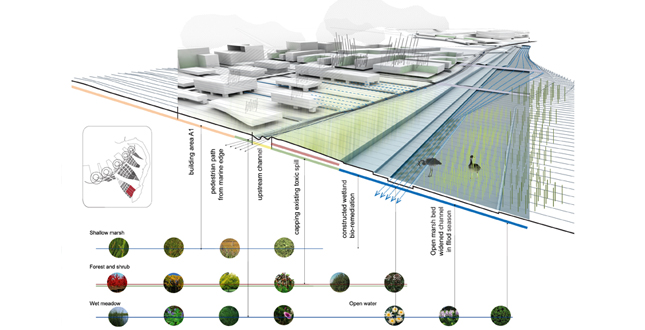 Close Me!
Close Me!Block zone A locates a t upper stream of flushing river. Water drains into the terraced riverine channels and infiltrates through constructed wetland. Vegetation species, such as acerrubrum, populous tremula, gleditsia triacanthos, are chosen to tackle with specific toxic elements (Pb, As, Al, Cu) existed on the site. Wetland species, such as phragmites, polygonum amphibium, typha latifolia, are chosen as creating enjoyable urban open space, as well as remediate contaminated marsh land and release clean fresh water into the upstream flushing river.
Download Hi-Res ImageImage: Chuhan Zhang
Image 9 of 14
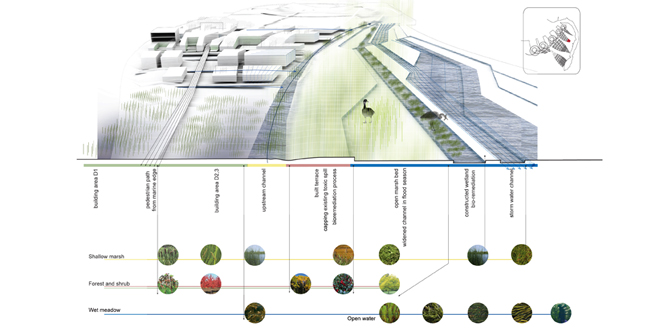 Close Me!
Close Me!Block zone D locates at lower reach of flushing river. With prominent concern of existed toxic elements flow into the river, phyto-remediation through built topography and capping of land is required for such site. Existing river sediment and silt can be processed for the capping of land. Stormwater is well-managed to drain through constructed wetland, shallow marsh and deep marsh. Weetland species, phragmites, polygonum amphibium, typha latifolia, and open water aqua plants, nymphea alba, elodea, ruppia maritime are chosen to tackle with contaminants as well as nitrogen pollution at the downstream river.
Download Hi-Res ImageImage: Chuhan Zhang
Image 10 of 14
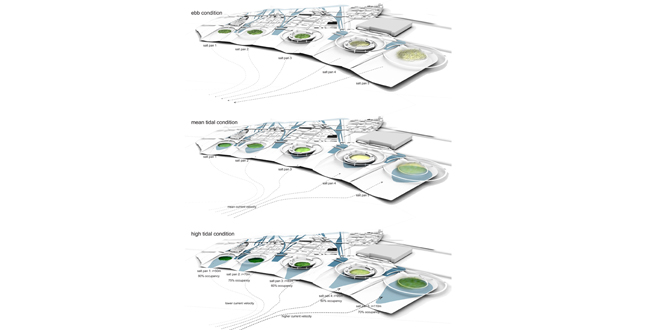 Close Me!
Close Me!Dynamic Flux. In terms of transforming the existing impenetrate hard edge into ecological soft edge, multiple salt plans are introduced along the sore. The width of each salt pan is determined through analysis of tidal velocity. Gradual slopes along the tide’s direction provides tidal plains with water occupancy maintained at certain percentage and depth, which offers salt works as well as attracting various marine habitats.
Download Hi-Res ImageImage: Chuhan Zhang
Image 11 of 14
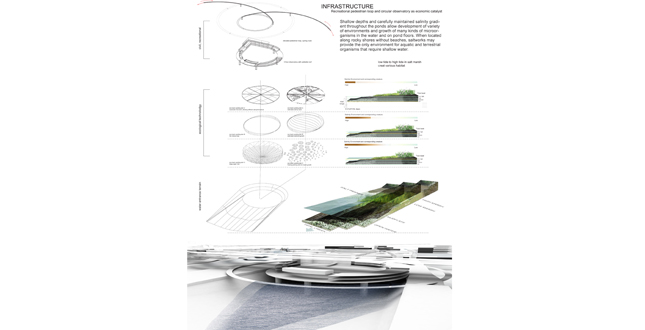 Close Me!
Close Me!Infrastructure. Shallow depts. And carefully maintained salinity gradient throughout the ponds allow development of variety of environments an growth of many kinds of microorganisms in the water and on pond floors. When located along rocky shores without beaches, saltworks may provide the only environment for aquatic and terrestrial organisms that require shallow water.
Download Hi-Res ImageImage: Chuhan Zhang
Image 12 of 14
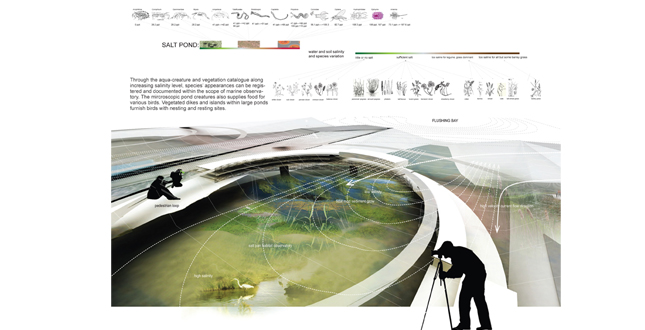 Close Me!
Close Me!Through the aqua-creature and vegetation catalogue along increasing salinity level, species; appearances can be registered and documented within the scope of marine observatory. The microscopic pond creatures also supplies food for various birds. Vegetated dikes and islands within large ponds furnish birds with nesting and resting sites.
Download Hi-Res ImageImage: Chuhan Zhang
Image 13 of 14
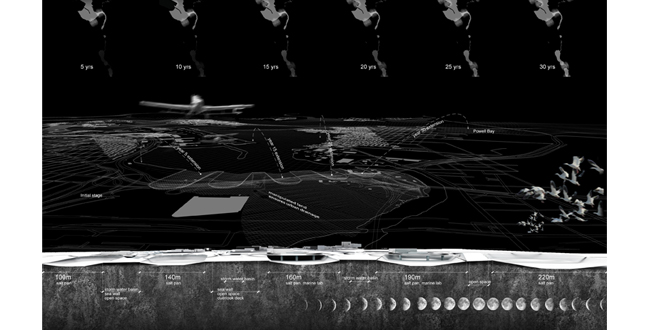 Close Me!
Close Me!Regional Potential Extension of Salt Pan Ecology and Stormwater Management. Willett’s Point envisions itself as a site that deals with flux of water as well as potential urban growth. It offers sustainable landscape infrastructure, incubates salt marsh estuary habitat, and stimulates healthier economic revival. The dynamic and flexible quality enables the project capable of adapting to various challenges. As a new paradigm based on the acknowledgement of common estuarine ecology, the strategy has the potential to extend further across Long Island sound, by managing healthier urban development, and reclaiming the shrinking salt marsh as mitigation of sea level rise.
Download Hi-Res ImageImage: Chuhan Zhang
Image 14 of 14
Project Statement
The project attempts to tackle with existing environmental issues of Willet’s Point, NY, by manipulating land form with optimized drainage system and water catchment, controlling the growth of urban blocks, and introducing salt pan as novel economic and ecological catalyst along the flushing bay. The design strategy takes advantage of superior regional access and public amenity adjacencies, Willet’s Point envisions itself as a site that offers sustainable landscape infrastructure, incubates salt marsh estuary habitat, and stimulates healthier economic revival.
Project Narrative
Existing Issues
Willet’s Point, a 60 acres peninsula on flushing river in Queens, NY, was built upon an ash dump. With remarkable transformation of surrounding area, Willet’s Point became environmentally-compromised. As states in a report by Army Corps of Engineers, “Over the past century, the bay’s entire ecosystem has been degraded through land fill activities” , due to the historical construction projects such as Laguadia Airport, World Fair Marina Dikes, Shea Stadium and Citi Field, the hydro-dynamics and the tidal circulation has been dramatically altered. Within such urbanization process, there is a transformation of a soft edge into sharp and impenetrate hard edge. This edge separates water and land, constructed infrastructure and the natural occurring system. Another concern is the urban runoff and the CSO outflow into the flushing creek and bay. Since Willet’s Point has no sidewalks or sewage system, flooding is rather common due to heavy rain. Besides, the site is filled with heavily polluted industry such as auto parts and repair shops, scrap yards, waste processing sites and small auto business. As a consequence, widespread petroleum and other automotive fluids contamination across the site have posed environmental hazards and endangered adjacent water bodies.
Opportunities and Objectives
The unique position provides enormous opportunities for urban growth as well as ecological significance in Willet’s Point and flushing bay estuarine area. With nearly 4 million people visit the neighborhood annually, its location has superior public transportation accessibility with #7 train, highway system, LaGuardia and JFK airport, and adjacency to Citi Field, downtown flushing, and Flushing Meadows-Corona Park. The tidal fluctuation, as another hydrological opportunity, offers unique estuarine habitat. With appropriate integration and transformation, it may tackle with sea level rise by mitigating the process, and activates the waterfront area of the site into new wild life conservation habitat with recreational and educational programs.
There is a concern that the amount of water flowing out in the form of CSO’s is not only contaminating Flushing Bay but also counteracting the inflow of the tide. In order to create a tidal habitat at Flushing estuary, it is important to reduce the impact of the CSO’s and increase the amount of water runoff that can be captured, stored, treated or allowed to naturally seep into the groundwater table.
Design Strategies and Ssocial-Environmental Impact
The proposal involves a hybrid system covering multiple phases. Systematic site strategies through sectional analysis embrace both the marine and riverine ecology. Major site transformation is through reframing the edge, altering from hard, impenetrate edge to soft, systematic and more productive edge. This allows for a better solution of the Flux City, which the intake and outlet of water is better controlled and managed. The initial stage of proposal is to reverse and transform such edges, by introducing salt pans sloping down with tidal flow direction; the received sea-water is gathered into the circular basin. The width of each salt pan is determined through analysis of tidal velocity. As sediment washes into newly opened salt ponds, it accumulates and begins to establish new tidal plains for marsh vegetation; water level being maintained at certain percentage and depth offers saline environment. Shallow depths and carefully maintained salinity gradient throughout the ponds allow development of variety of environments and growth of many kinds of microorganisms in the water and on pond floors. When located along rocky shores without beaches, salt works may provide the only environment for aquatic and terrestrial organisms that require shallow water. Through the aqua-creature and vegetation catalogue along increasing salinity level, species’ appearances can be registered and documented within the scope of marine observatory. The microscopic pond creatures also supplies food for various birds. Vegetated dikes and islands within large ponds furnish birds with nesting and resting sites. The pedestrian loop above salt pans extends the walking experience; the outer loop creates linkage with existing roads and new approach to the waterfront. This strategy reframes the relationship between salt marsh ecology and urban infrastructure, by integrating them in a synergetic system. Five aligned salt pans and corresponding structures sets the growing point for new urban ground.
Urban fabric is developed from the proposed urban watershed situated on the landscape divisions. It also envisions multiple urban density scenarios. Pedestrian sidewalks and public transportation underline the landscape features, and enhance the regional accessibility. Block drainage system is deployed across the site from the typological studies. The manipulated flow pattern of building block decides the division line and water-land ratio. Various vegetation habitats as courtyards and wetland will fit into respective hydro-condition. Urban area is divided into 4 zones. Principles such as location along river, flooding inclination and existing contaminants on site appeal its corresponding landscape regime. For example, Block zone A locates at upper stream of flushing river. Water drains into the terraced riverine channels and infiltrates through constructed wetland. Vegetation species, such as acer rubrum, populus tremula, gleditsia triacanthos, are chosen to tackle with specific toxic elements (Pb, As, Al, Cu) existed on the site. Wetland species, such as phragmites, typha latifolia, are chosen as creating enjoyable urban open space, as well as remediate contaminated marsh land and release clean fresh water into the upstream flushing river. Block zone D locates at lower reach of flushing river. With prominent concern of existed toxic elements flow into the river, phyto-remediation through built topography and capping of land is required. Existing river sediment and silt can be processed for the capping of land. Storm water is well-managed to drain through shallow marsh, deep marsh and open water. Wetland species, polygonum amphibium, typha latifolia, and open water aqua plants, nymphea alba, elodea, ruppia maritima are chosen to tackle with contaminants as well as nitrogen pollution at the downstream river. This strategy addresses multiple strata of urban ecology by making water a more connective element and also uses storm water more productively as responsive ecological corridor. The design uses layers of wetland to create continuous natural habitat along flushing creek. These green conduits can increase the experience of the street to the edge. Performative of waterflow can act as new occupiable green space that allows the city to continue to grow as a dense green and healthy urban estuary.
The complex interface of the fresh and salt water system creates a bio-diverse eco system, the result is a self-sustaining infrastructure that includes salt pan growing into marsh that align on the outer edge, reconstructed urban edge to manage the risk of sea level rise, channels with sidewalks as continuous system, vegetations to adapt to different level of salinity with different species to adapt to periodically inundation
Willet’s Point envisions itself as a site that deals with flux of water as well as potential urban growth. It offers sustainable landscape infrastructure, incubates salt marsh estuary habitat, and stimulates healthier economic revival. The dynamic and flexible quality enables the project capable of adapting to various challenges. As a new paradigm based on the understanding of common estuarine ecology, the strategy has the potential to extend further across Long Island sound, by managing healthier urban deployment, and reclaiming the shrinking salt marsh as mitigation of sea level rise.





